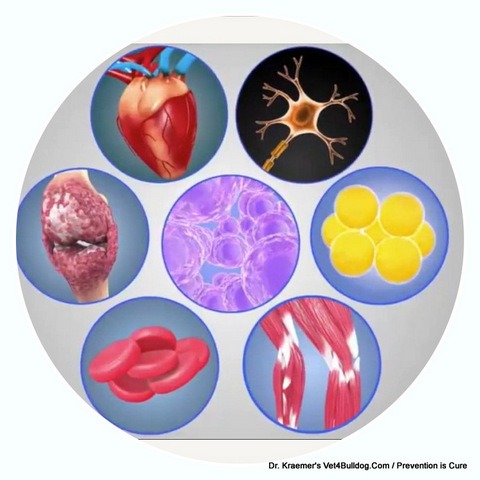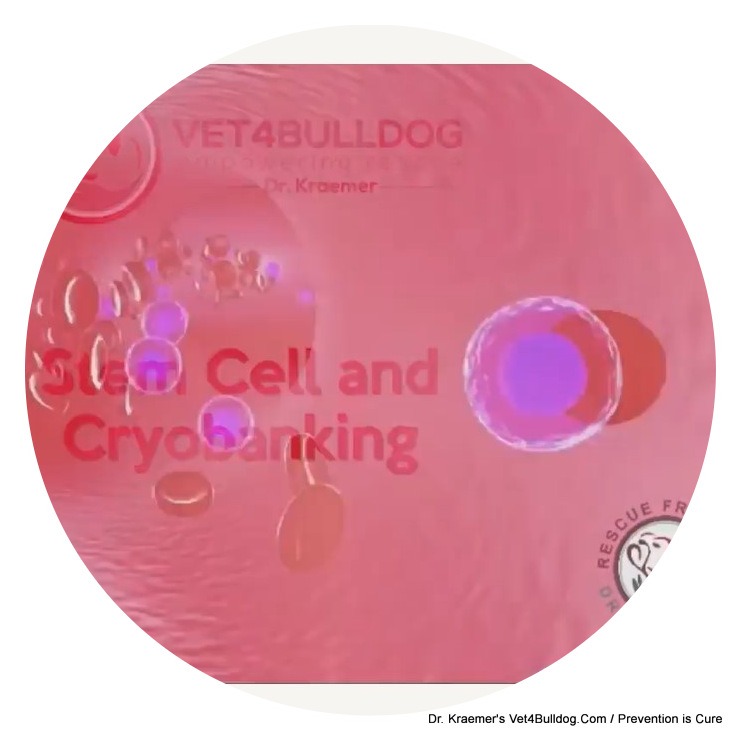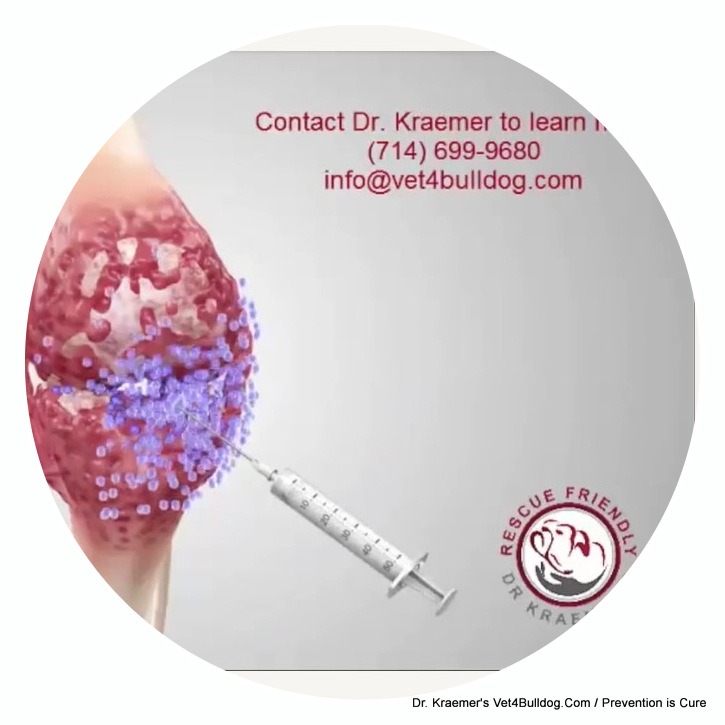Stem Cell Therapy for Arthritis in Dogs and Cats
Stem cell therapy for arthritis in dogs and cats is a state-of-the-art, non-pharmaceutical, and therapeutic treatment modality. Stem cells are your pet’s own repair cells waiting to be called on when injury to your dog or cat’s joints occurs and as arthritis and joint wear and tear progress.
Stem Cell Therapy for Arthritis in Dogs and Cats ACTIVATION:
Your pet’s stem cells are extracted from their fatty tissue and processed with Platelet Rich Plasma (PRP) into an injectable solution, which is then activated using LED Light technology.
Following activation, those supercharged, highly concentrated stem cells are then injected directly into your dog or cat’s arthritic joints, ready to start the repair and healing process.

In addition to their anti-inflammatory and pain-relieving abilities, your pet’s stem cells have the ability to divide and differentiate into muscle, bone, and cartilage.
For nearly a decade, Dr. Kraemer has been a leading provider of this groundbreaking regenerative therapy, providing an alternative to the traditional treatment of arthritis and other medical conditions.

Dr. Kraemer’s practice is equipped with an in-house stem cell laboratory, which allows for it to be a same-day procedure, minimizing cell death as well as additional visits for treatment administration required by other stem cell companies.
Stem Cell Therapy for Arthritis in Pets CRYOBANKING:
Dr. Kraemer also offers StemCell cryobanking services which allow pet owners to bank additional treatments for future use as well as a low-cost “Cryobanking your Pet’s Future Health program” for elective procedures like spaying and neutering puppies and kittens.
Stem Cell Therapy for Arthritis in Dogs and Cats / SAFETY:
Stem cell therapy for arthritis in dogs and cats has no serious side effects, no extensive recovery time, minimal discomfort, and only a sort of post-op confinement requirement.
The stem cells can be injected into multiple joints at once, and treatments can be repeated months to years later by cryobanking additional treatments.
Lastly, treating your pet’s arthritis and chronic pain with traditional drugs over an extensive period of time can be expensive and, unfortunately, in some cases, bring on unwanted, harmful side effects.
Stem Cell Therapy for Arthritis in Pets PAIN-RELIEF:
Arthritis in cats and dogs, also commonly known as osteoarthritis and degenerative joint disease (DJD), is usually a painful medical condition.
As with humans, the painful, inflamed, arthritic joint of your pet is a progressive, degenerative disease that worsens with time. Arthritis affects the smooth articular cartilage of your cat’s or dog’s joints. This cartilage is responsible for covering and protecting the bone in the joint and allows your pet’s joints to move and bend without pain.
When the cartilage lining the joints becomes injured and worn down, the bone loses its protection. The now exposed articulating bone parts start rubbing against each other when your pet is in motion, causing inflammation and pain.
Chronic pain due to arthritis is a growing problem in older cats and dogs.
Unfortunately it is not uncommon for our arthritic pets to live in pain under diagnosed.
Stem Cell Therapy for Arthritis in Bulldogs OWNERS TESTIMONIALS:
Many arthritic dog owners report to me that their pet is slowing down, limping, favoring a leg, and unable to take long walks or play as they used to. Other changes in activity also include your pet’s inability to climb into a chair or bed and having difficulty getting upstairs or going downstairs.
Often, pet owners of arthritic dogs will report that their pet is slow to get up, but mobility improves as their pet begins to move around throughout the day. However, for pet owners of cats, recognizing the osteoarthritis of their beloved feline can present a challenge since arthritis in cats is much more subtle.

For most pet owners of an arthritic dog or cat, this condition is associated with
- hip dysplasia
- ACL injuries
- patella luxation
- elbow dysplasia,
Yet it is not limited to those joints.
Dr. Kraemer’s Arthritis Pets PREVENT & TREAT
WEIGHT LOSS:
Arthritis and arthritic pain can be eased and managed by weight management and weight loss.
BALANCED QUALITY DIET:
A balanced diet and daily activities are vital for a healthy muscle tone and for your pet’s range of motion.
THERAPEUTIC SUPPLEMENTS
- V4B Total Joint
- V4B Fish Oil
- V4B HEMP Mobility
- V4B Comfort and AcheLess
- V4B Immune Support
Cryobanking your pet’s stem cells while they are young during elective surgery like spaying and neutering can provide them with a safe, inexpensive, and effective “anti-arthritis”, pain relief alternative for years to come.
Dr. Kraemer’s Stem Cell Therapy for Arthritis Rule of Thumb
Chronic Pain due to arthritis in dogs and cats is much more prevalent than we previously thought. Tragically, arthritis in pets is grossly and systemically underdiagnosed.
Many of our pets suffer from unnecessary and chronic arthritic pain.
The earlier your dog or cat’s arthritis is treated, the better the prognosis.
Dr. Kraemer’s Stem Cell Therapy for Arthritis Tips & Warnings
Pet Arthritis Alternative Therapies
Dr. Kraemer now offers highly effective anti-inflammatory therapies. These new-age anti-arthritic modalities are, low-cost, non-invasive, pain-free and with no known short or long-term accumulative adverse effects other traditional drugs are known for. These modalities include Class 4 Cold Laser Therapy, Pulse Electromagnetic Field (PEMF) , and Plasma-rich Platelet Therapy (PRP).
Pet Arthritis Obesity Tip
Your pet’s arthritis and arthritic pain can be treated in multiple ways. Obesity is a large factor in the progression of arthritis, therefore, putting your dog or cat on a special veterinary weight loss diet, as well as proper and moderate exercise, can be very helpful.
Pet Arthritis Joint Supplement
Joint supplements like Dr. Kraemer’s
Arthritis in Pets Fish Oil Supplement
Daily feeding with an Essential Fatty Acid mix of Omega 6 and Omega 3 (EFA 3-6)might help your arthritic dogs and cats due to the supplement’s anti-inflammatory properties.
like Dr. Kraemer’s
Cat Arthritis Behavioral Change Tip:
Arthritic cats with chronic pain often show behavioral changes. They might become atypically depressed, withdrawn, aggressive, and/or nervous.
Arthritic Painful Cat Tip:
Arthritic cats with chronic pain might need a litter box(s) that provides easy access. A cat that is starting to have “accidents” despite years of the normal use of his/her litter box should be examined for arthritis in addition to common cystitis.
Arthritic Pet House Proofing Tip:
Owners of arthritic dogs and cats should place their pet’s water and food dishes on accessible surfaces rather than high countertops such as the ground level of their home.
Pet Arthritis Aging Tip:
Dogs and cats who are otherwise active and energetic and appear to “age” and/or “slow down”, might be exhibiting pain due to arthritis. Remember, “age is not a disease”.
Pet Arthritis Elbows and Hips Tip:
Elbows and hips are the most commonly affected joints in cats with osteoarthritis.
Arthritic Pain in Pets Radiographs Tip:
Arthritic cats often have more than just one joint affected therefore radiographs of all joints are recommended
Pet Arthritic Pain Bed Tip:
The bed(s) of your arthritic dog and cat should be soft, thick, and warm. Place your arthritic pet’s beds at multiple locations around the house and at ground level to avoid climbing or/and walking downstairs.
PETS ARTHRITIS WARNINGS:
Arthritic Pain in Pets Warning:
Dogs and cats suffering from arthritis and arthritic pain will generally display noticeable signs. These signs/symptoms include swollen joints, lameness, muscle disuse atrophy, and limping.
Arthritic Pain in Pets Steroid Warning:
Some veterinarians recommend treating dogs and cats with advanced arthritis and arthritic pain with corticosteroids (Pred). These drugs may provide temporary pain relief but have potential long-term adverse effects. There are safer, non-steroidal analgesic drugs for the management of your dog’s chronic arthritis and arthritic pain relief. Non-steroidal anti-inflammatories (NSAIDs), are now also available for cats but only for short-term use.
I’ve seen improvement every week since. Although the stem cell did not make Spoofy a younger dog…she is definitely a healthier old dog.
She seems to be pain free, has a great appetite, loves car rides and can walk up to 1.25 miles at a time. I also noticed that 90 percent of the fatty cysts she had all over her body, including a larger mass on her side, completely disappeared.
I truly believe the stem cell treatments and Dr. Kraemer have given Spoofy that last hope we were looking for and a better quality of life.
Thank you!! Darcie Copeland”










